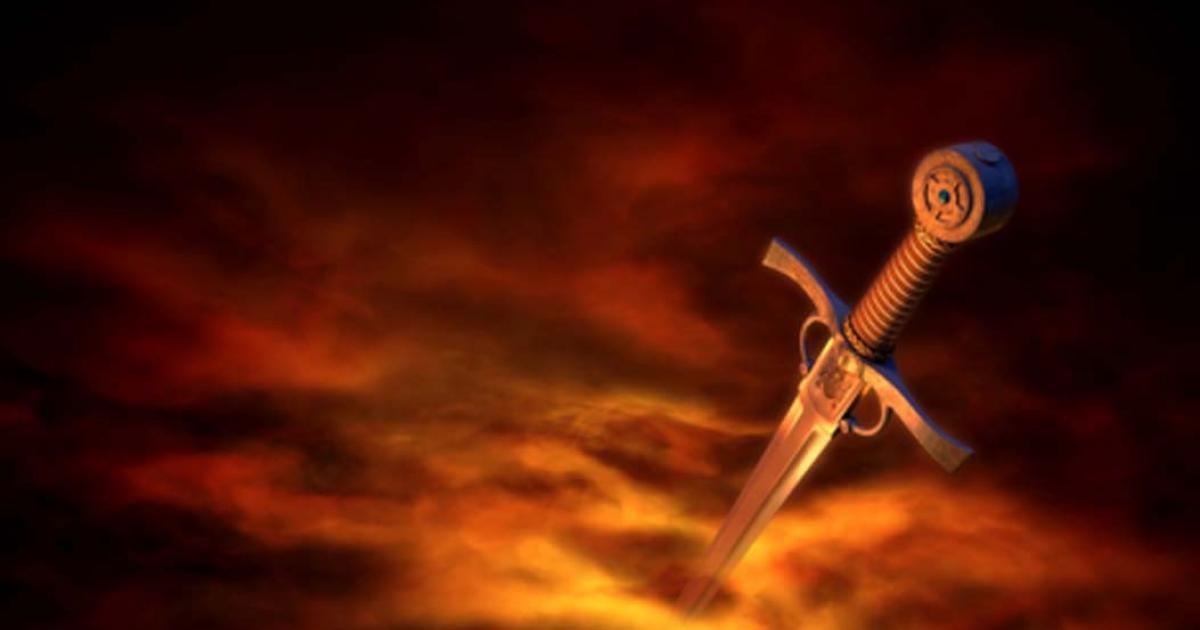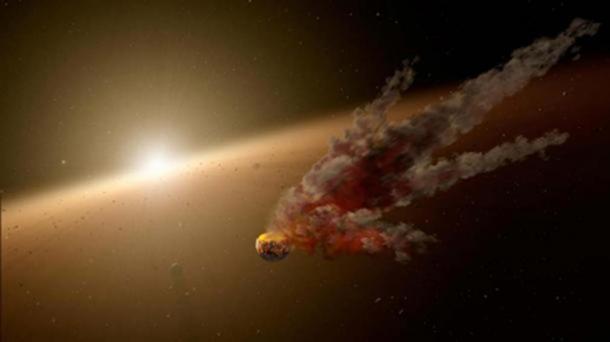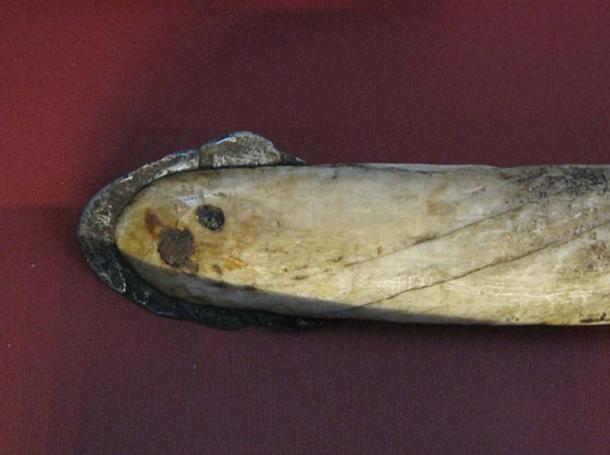
Meteorite Swords Forged from the Fire of the Heavens
From the earliest conscious moments of the human race, we looked up into the distant night sky in wonder and amazement. Our early ancestors glanced at the same skies we see today and pondered the mysteries of the universe. What lay beyond the distant darkness? What magical, fiery balls of light lay in that shivering endlessness? Well, sometimes, the starry skies gave them an answer.
So we should not be surprised that when once in a blue moon one of these celestial bodies came hurling down to earth its remains would become a highly sought and prized artifact. And in just a few cases, these fiery cosmic remnants would be used to forge sophisticated and deadly weapons, whose magnificence would lead them straight into legend and myth.
But is there truth to these legends? How rare are meteorite blades actually?
Celestial Fire – The Earliest Mention of Meteoric Swords
Many meteorites that come crashing to the Earth are in general useless for metallurgy. Their stony composition can’t really be used for smelting as they are mostly similar to your run of the mill rocks. But there are a select few meteorites that are composed from a combination of iron and nickel. This combination and the result of its smelting is almost completely rust proof, high quality, and easily recognized as metal.
- Space Rock Mystery: Where Did the Fukang Meteorite Come From?
- Farmer Discovers He’s Been Using a Meteorite As a Doorstop…And It’s Worth $100,000

Daggers found within King Tutankhamun's burial wrappings. The top one is of made of gold and the lower one is made from meteorite. Source: ancient-egypt.co.uk
The main difference of meteoric iron from the regular one is a high nickel content which goes from 5% to 26%. Moreover, it is very malleable, meaning that it is easy to work with. So it should be no wonder that even the earliest and most primitive civilizations of our past have utilized these celestial ingredients and the use of it dates to as early as 8000 years before present. To put that in perspective, the use of meteoric iron predates by far the coming of the Iron Age in the Old World.

An endcut from the Toluca iron meteorite. (H. Raab/CC BY SA 3.0)
The use of the iron from meteors was attested to in some of the world’s major civilizations. And in each culture it was considered something sacred and powerful beyond all measure. In the Sumerian civilization, meteoric iron was called an bar, which means “fire from heaven”.
The Hittite name ku an means the exact same thing. And in ancient Egypt, its name was bia en pet, which roughly translates to “thunderbolt from heaven”. In the early Middle East, it was called ahan I barq – “lightning iron”, and in Assyrian it was barzu ili – “metal of heaven”. All of these names point to its celestial origins.
The story of traditional iron smelting has a troubling origin. People knew gold and copper way before iron, so when they discovered these meteors and the high quality, durable material it produced, they were astonished. One early mention of this comes from Hittite sources, where they state that “ gold comes from Birununda, the copper from Taggasta, but the iron comes from the heaven”.

Iron from meteorites was sometimes called the “metal of heaven.” (Public Domain)
And from the many sources that exist, as well from archaeology, we can deduct that the use of meteoric iron in smelting was definitely occurring worldwide, from South America, to Europe, the Middle East, Asia, Africa, and the Arctic. And over the course of time, several impressive artifacts were fashioned from this celestial iron.
One of the earliest of such items dates to 3200 BC Egypt, roughly 2000 years before the onset of the Iron Age. The items are iron metal beads, containing almost 7.5% nickel. The beads were discovered in 1911 by a prominent Egyptologist of the time, Gerald Avery Wainwright.
These beads, considered by most as the earliest example of the use of iron, were unearthed at the site at Gerzeh on the banks of the Nile. This location contained the remains of the Gerzeh culture, also known as the Naqada II, which was one of the earliest forms of the subsequent Egyptian civilization. The 9 tubular beads were found in two different graves. And as Wainwright himself said, this earliest usage of meteoric iron clearly tells us that the iron in Egypt, as in many other countries, was obtained from meteorites long before the Iron Age set in.

The Earliest known ancient Egypt iron object: a meteorite iron bead from a prehistoric cemetery. (Diane Johnson/The Manchester Museum)
Iron Before the Iron Age – From Tutankhamun to the Inuit
Another one of the earliest meteoric weapons is the so-called Alaca Höyük meteoric dagger. This impressive weapon was discovered in the eponymous site in today’s Turkey, and is dated to around 2500 BC. This impressive weapon, still remarkably well preserved, most likely had a ceremonial purpose, and was decorated with an elaborate solid gold hilt. The weapon belonged to the Hattian culture, a prominent proto Anatolian civilization that flourished from at least 3000 BC until their assimilation roughly a millennium later.

Dagger with iron blade and golden hilt from Alaca Höyük. Early evidence for the use of iron in Anatolia. (Stipich Béla/CC BY SA 3.0)
But easily the most famous discovery of meteoric weapons dates to roughly 1350 BC Egypt, and belonged to the famous King Tut. This weapon, known as Tutankhamun’s Iron dagger, was discovered by the famed Egyptologist Howard Carter in 1925. The blade contains a high percentage of nickel, as much as 11%, which is a clear confirmation of its meteoric origin.
The rich, solid gold decoration of the hilt and the sheath, as well as its obvious ceremonial purpose, indicate that weapons of this type were rare and almost non-existent, indicating their connection with only the most powerful individuals.

Fallen star sword. (Daniella Comelli/University of Pisa)
Advanced and ancient civilizations weren’t the only ones who knew the use and efficiency of meteoric iron. One such example are the Inuit peoples of Greenland. These inhabitants of the cold north have utilized the scattered remnants of the ancient Cape York meteorite to fashion a variety of useful tools that were much more effective and durable than their usual bone and stone implements of the time.
- People of the Arctic worked meteorite iron 1,200 years ago
- Why did Tutankhamun Have a Dagger Made From a Meteorite?
This meteor, one of the largest in the world, crashed on Meteorite Island of Greenland millions of years ago. And its remains, some weighing up to 30 tons, were always known to the local Inuit people, particularly for the content of iron. They’d travel long distances to these stones and chip off small bits and pieces, which they would then cold forge into useful shapes.
Cold forging means that no fire was used in the process, but the stones were rather stamped and hammered into shape. This was only possible due to the malleable nature of meteoric iron. The most usual application of this iron was as harpoon tips and knife blades – all usually affixed onto Narwhal tusks.

An Inuit lance with an iron meteorite head (Cape York meteorite) in the British Museum. (geni/CC BY SA 3.0)
From the Heavens Into the Hands of Emperors
You might think that the use of meteoric iron faded with time, and that the novelty of these weapons faded with time. But the truth is far from that. The smelting of meteoric iron continued well into the Middle Ages and after, albeit at an equally slow pace. Such weapons remained ultra-rare and were reserved only for the most powerful of rulers.
One of the earlier “modern” examples of such weapons dates to around 1621 AD, to Jullundar in India and the time of the Mughal Emperors. This is the modern town of Jalahandar. The account of the creation of these meteorite swords tells us in detail how the entire process occurred, from meteorite to weapon.
In March – April of 1621, the then town of Jullundar was shook by a fearsome explosion. The account states that many witnessed the falling star from the heavens –the meteorite. Soon after the explosion and the noise subsided, a local collector of certain prominence – one Muhammad Sa’id – was contacted to investigate the crash site. What he discovered was an enormous crater, with the ground burned and extremely hot at the center.

Slice of another meteorite that fell in India. This one fell on September 12, 2008 in Tamil Nadu. (Jon Taylor/CC BY SA 2.0)
Sa’id ordered his workers to dig on the site, and when they reached a certain depth they discovered a molten, red hot lump of iron. Now, Muhammad Sa’id was seemingly a knowledgeable man. He at once got the idea of what it was exactly that he had stumbled upon, and so he excavated the iron lump once it was cooled.
To gain favor at the court, he delivered it to Jahangir, the fourth Mughal Emperor, also known as Nur-ud-din Muhammad Salim. The emperor then employed his most skilled blade master, Usad Daud, and ordered him to craft a sword worthy of an emperor from this iron which they called ahan I barq – “lighting iron”. The master eventually delivered two magnificent swords of the highest quality, which were from then on known as Shamsher I Qati – “Cutting Sword”; and Shamsher I Barq-sirisht – “The Lighting Natured Sword”.
But one of the most interesting stories of meteoric swords dates to quite modern times, and is connected to a prominent English man named James Sowerby. Sowerby is widely known as one of Britain’s chief naturalists, illustrators, and mineralogists of the 19th century, and one of the most prominent researchers of meteorites. But what is less known about him is the story of his magnificent meteoric sword.
The story of the sword begins with a single, 84 kg (185.19 lb.) specimen of a much larger meteorite that landed in ancient times in the Cape of Good Hope. It was discovered on a plain east of the Great Fish River in southern Africa, in the 18th century. Mr. Sowerby received a part of this large specimen on account of his esteemed knowledge of meteorites, and it was given to him for study and further research.
Several years later, Sowerby was much inspired by the conclusion of the War of the Sixth Coalition and the abdication of Napoleon in 1814, and moreover, highly enamored with the heroic person of Alexander I, Emperor of Russia. In hopes to commemorate this iconic event and show his admiration for the Emperor, James Sowerby decided to have a piece of his meteorite fashioned into a sword and subsequently presented to Emperor Alexander I as a gift.

Sowerby's sword and scabbard presented to the Emperor Alexander I, 1814. The State Hermitage Museum, St Petersburg. (Konstantin Sinyavsky/The State Hermitage Museum)
The first fashioning of the meteoric iron into a sword was done at the “ Patent Press Steam Engine and Machine Manufactory” of Henry Maudslay and Co, at Cheltenham Place, Lambeth. For this service, Sowerby had to pay 4 shillings 6 pence. Afterwards, he employed the services of one John Prosser, “ Manufacturer of Arms and Accoutrements to the King and their Royal Highnesses the Prince of Wales, Dukes of York, Kent and Cumberland, No 9 Charing Cross”. This artisan completed all the finishing touches, such as the sharpening and the addition of a handle and a scabbard.
The sword was engraved with an inscription composed by Sowerby himself, which stated:
“This Iron, having fallen from the heavens was, upon his visit to England, presented to His Majesty ALEXANDER, EMPEROR of all the RUSSIAS, who has successfully joined in Battle, to spread the Blessings of PEACE throughout EUROPE.
By James Sowerby F.L.S. G.S. Honorary Member of the Physical Society of Göttingen & c, June 1814.”
- Falling Stars and Black Stone: Humanity’s Worship of Meteorites
- Space Rock Sold! 4.5-Billion-Year-Old Meteorite is the Oldest Item Ever Sold on Earth
After its completion, the sword had a lengthy journey in order to be presented as a gift to the Emperor. At first Sowerby met with many failures, but eventually he received the letter that confirmed that Alexander I did receive the gift and enjoyed it immensely. Sowerby also received an exquisite ring with diamonds and precious stones, as a sign of thanks.
In the decades that followed, the sword and its whereabouts faded into obscurity, until they were re-discovered in the possession of the St. Petersburg’s State Hermitage Museum. To date, this meteoric sword remains one of the finest examples of weapons made from a celestial object.
Celestial Secrets in Your Hand
The art of meteoric sword making is not entirely gone out of practice. One of the most recent examples is Tentetsuou, an exquisite katana that was forged from the ancient Gibeon meteorite, by the renowned swordsmith Yoshindo Yoshihara. And meteoric iron still remains one of the prized ingredients in crafting swords, daggers, jewelry, and other curiosities.

Tentetsuou. (MarcianosMX.com)
But what never fails to amaze us is the incredibly old tradition of utilizing meteorites to craft weapons of incredible beauty and quality, and the primeval connection of man and outer space. The secrets of the celestial realm remain hidden in these magnificent and deadly blades.
Top Image: Meteorite swords came from the heavens. Credit: mdorottya / Adobe Stock
References:
Burke, G. J. 1986. Cosmic Debris: Meteorites in History. University of California Press.
Föll, H. Meteoritic Iron. Iron, Steel & Swords. [Online] Available at: https://www.tf.uni-kiel.de/matwis/amat/iss/kap_a/advanced/aa_2_4.html
Henderson, P. 2013. James Sowerby: meteorites and his meteoritic sword made for the Emperor of Russia, Alexander I, in 1814. The Royal Society Publishing. [Online] Available at: https://www.ncbi.nlm.nih.gov/pmc/articles/PMC3826197/
Rapp, G. 2002. Archaeomineralogy. Springer.
Rickard, T. A. 1941. The Use of Meteoric Iron. Royal Anthropological Institute of Great Britain and Ireland.
Various. 1869. Proceedings of the Asiatic Society of Bengal. Library of Princeton University.
















Comments
Thank you for this article. It’s wonderful. So, the universe really doesn’t waste anything and neither did our ancestors.